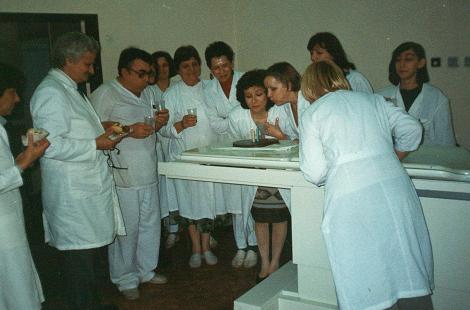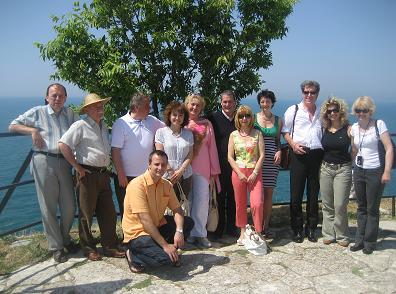In April 2008 the Bulgarian Society of Nuclear Medicine celebrated 50th Anniversary of the Nuclear Medicine setting in Bulgaria.
Nuclear Medicine in Bulgaria started in Sofia in the beginning of 1958 at the same time in the Department of Radiology to the Alexandrovska University Hospital, directed by
Prof. Ushev, in the Institute for postgraduate education, directed by Prof. Kaneti and in the National Research Institute of Oncology, directed by Prof. Oreshkov for applying radio-nuclides for metabolic therapy and diagnostics. Soon after that the Department of Nuclear medicine to the University Hospital in Plovdiv, directed by Prof. Bozduganov, was opened. In the 60ies and 70ies 10 new laboratoriesof Nuclear Medicine were opened to the larger hospitals in the country and in the Oncology Dispensaries, in Varna, headed by Dr. Tranulov, in St. Zagora, headed by Dr. Vlahov, in Russe, in Vratza, in Veliko Turnovo etc.
The first nuclear medicine examinations were introduced as follows: Thyroid scintigraphy and endocrinology (B. Barliev, P. Nikolov, T. Katzarov, N. Peshev), nephro-urology (E. Shieretova, L.Salambashev, V. Oreshkov), Liver, spleen and pancreas scanning (J. Kaneti, Hr. Ivanov), Lung perfusion (P. Nikolov, K. Valev, H. Hadjikostova), Cardiac (E. Sheiretova), Lymphoscintigraphy and bone scintigraphy (Hr. Mlachkov), Brain and liquor scintigraphy (P. Nikolov, St. Sultanov), beta32P detection in malignant melanoma (Oreshkov and R. Ikonopisov), tumour imaging on the Cassen’s scanner with radiolabelled bleomicyne (V. Oreshkov).
In vitro radioimmunoassay started in 1968 at the same time as in the USA, France, the United Kingdom and Germany with entirely home made products and standartization (St. Milanov, Tarkolev).Evaluation of thyroid, pituitary, sex, adrenal hormones, insulin and a dosage of biologically active products were studied. After the first in vitro laboratory, in vitro nuclear medicine diagnostic sections were started in all nuclear medicine departments all over the country.
The national milestones of nuclear medicine:
1958
First three Departments of Nuclear medicine in Sofia in University hospital “Alexandrovska”, Institute for postgraduate education National Oncology Center and a start for Cassen’s scanners installation.
1968
In vitro radioimmunoassay started in Sofia.
1968
Beta-32P detection of a malignant melanoma by R. Ikonopisov.
1973
First gamma-camera was installed in Military medical Academy
1975
First radioimmunolgand methods were established for evaluating the hormonal
1975
Receptors – estradiol and progesterone in breast cancer in the Department of Nuclear Medicine in National Oncology Center by Dr. Tzingilev after his Humboldt’s fellow-ship in Germany.
1976
The second gamma camera in Medical University “Alexandrovska” Hospital.
1983
Gamma-camera especially for cardiac studies in Fifth City Hospital in Sofia, introduced by Dr. Yanakiev and Dr. Chakarov.
1990
Nuclear Medicine was accepted as a separate speciality in Bulgaria
1992
First SPECT gamma-camera in National Oncology Center was introduced for the development of a contemporary nuclear oncology imaging by Dr. E. Piperkova (Fig.1).
1995
Introduction of the limphoscintigraphy of the sentinel Lymph node well established with surgery gamma probe and histological verification as a routine procedure in malignant melanoma, breast cancer and in other neoplasm staging in the National Oncology Center in Sofia.
1995-2008
21 Nuclear medicine Departments in Bulgaria equipped with gamma-cameras.
2003
National Standard of Nuclear Medicine was officially established in Bulgaria.
2009
First SPECT/CT scanners in University “Alexandrovska” Hospital and in Sofia City Oncology Dispensary, directed by Prof. I. Kostadinova (Fig. 2) and Dr. P. Chikov respectively.
2009
Upgraded National Standard of Nuclear Medicine in compliance with the European. Standard was officially upgraded.
2009
First PET/CT started in the Department of Nuclear medicine in University Hospital “St. Marina”, directed by Prof. A. Klissarova.
2010
Next PET/CT opened the door in 2010 in University Hospital
“Alexandrovska”.
The establishment of the Bulgarian Society of Nuclear Medicine:
The Bulgarian Society of Nuclear Medicine (BSNM) was founded in 1995. Till 1995 Nuclear medicine was a part of the Bulgarian Association of Radiology. Prof. Dr. Stefan Milanov became the first President of the BSNM. The next President, elected in 2003 was Prof. Irena Kostadinova. The current President of the Bulgarian SNM is Prof. Elena Piperkova.
We have 65 members: physicians, medical physicists, radio-chemists, engineers. The Committee of Technologists was established in 2008.
Every two years the Bulgarian SNM participates in a separate Session of the Bulgarian Congress of Radiology. Our members participate in the EANM Congress learning activities and in the initiatives of the Radiation Protection Committee, and also in courses and workshops, organized by IAEA. Our own Program for Internal Quality control was started in 2005.
Our eminent nuclear medicine specialists are members of Editorial Boards not only to Bulgarian scientific journals as Rentgenologia & Radilogiaq Oncologiaq etc but also in International Journals as World Journal of Nuclear Medicine (Prof. E. Kostadinova, Prof. A. Klissarova, Prof. E. Piperkova), the Hellenic Journal of Nuclear Medicine (Prof. D. Tzingilev, Prof. I. Kostadinova, Prof. Klissarova, Prof. E. Piperkova, Prof. T. Hadjieva), the Turkish Journal of Nuclear Medicine (Prof. I. Kostadinova), the Polish Journal of Nuclear Medicine (Prof. E. Piperkova) etc.
As of 2003 an annual meeting of the guild of BSNM is held at the first weekend of June, as well as regional meetings of the Society, related to the opening of new equipment, courses for improvement the qualification of those working in the sphere of nuclear medicine and workshops. Leading world experts take part in these annual meetings of the guild of BSNM, at the Society’s invitation, and we may proudly state that meeting s with friends such as Prof. K. Britton, Prof. W. Knapp, Prof. Al Nahas, Prof. Talbot, Prof. Kluge, Prof. Galuska, Prof. Solodiannikova, Dr. Savvas Frangos, Mikecz Pal, Dr. Sagan, Dr. A. Balenovič etc., offer a very good possibility for training, improving the qualification in Nuclear medicine, exchange of expertise and nuclear medicine team bilding (fig. 4).
From the beginning of the development of Nuclear Medicine in our country
18 dissertations for acquiring the degree of „Doctor of Medical Science” have been defended, and more than 45 physicians received a PhD degree “Doctor”. During the years 16 of them achieved the title Professor of Nuclear Medicine and 18 became Associate-professors.
Nuclear medicine in Bulgaria today
20 clinics, wards and labs are currently operating in Bulgaria of which 10 are located in Sofia and 10 throughout the country distributed in 6 Euro-regions.
Nuclear Medicine is taught as a subject to students and PhD students in all 6 Medical Universities and certified University hospitals by 6 professors (Irena Kostadinova, Doichin Minchev, Anelia Klissarova, Mariana Yaneva, Elena Piperkova, Dimitar Tzingilev) and Associated Professors (Marina Garcheva, Toshko Petrov, Antonia Tzonevska, Donka Vassileva, Miroslav Donchev, Anna Simeonova, Margarita Radeva, etc.).
Many of the specialists in Bulgaria have been educated in leading centers of Nuclear Medicine headed by renowned specialists such as Prof. K. Britton (UK), Prof. H. Abdel-Dayam (USA), Prof. W. Knapp and Prof. R. Kluge (Ge), Prof. A. Cuocolo (I), , Prof. D. Slosman and Prof. E.Nitzshe (Switzerland), Prof. A. Padhy, Prof. Lee (S.Korea) etc.
New diagnostic image methods and therapeutic schemes are applied and continually being introduced, observing the national standard within the framework of the European traditions along the different lines of Nuclear Medicine : Nuclear Cardiology, Nuclear Oncology, Nuclear Neurology, Nuclear Hematology, Nuclear osteology, Nuclear Endocrinology.
In the conditions of reforms in the healthcare area, the limited production capacities in Europe and throughout the world of 99mTc-Generators, some normative restrictions in the production of kits, the conditions of the economic crisis impose limitations in the application of the diagnostic and therapeutic procedures of Nuclear Medicine, which has a negative impact on the development of this speciality to aid the needy patients.
The future of Nuclear medicine in Bulgaria:
In the spirit of existing traditions in education and application of Nuclear Medicine in Bulgaria, the main future perspective for our speciality is to continue developing different nuclear medicine procedures, making them more and more accessible to the patients, showing the right place of the metabolic imaging and therapy in the diagnostic and therapeutic algorithms.
Well-distributed PET/CT in Bulgaria will be an excellent possibility for an impact mainly in clinical oncology but also in neurology and cardiology. PET metabolic imaging is more accurate than CT alone in evaluation a viable tissues or neoplastic lesions as well as treatment response. According PET/CT studies patient management changes are implemented. The common problem to delivery 18F-FDG or any other short half-live positron emitters should be solved by establishing a cyclotron in the country.
To continue the nuclear medicine education, participation in international projects and the training of a new generation of specialists is expedient.

T. Boiadjieva, Dr. S. Sergieva, Dr. M. Nenovska.

Fig.2. First SPECT/CT in Bulgaria installed in February 2009 at the Central Laboratory of Nuclear Medicine in the University Hospital “Alexandrovska” in Sofia. From left to right: Dr. V. Hadjiiska, Prof. Assoc. T. Petrov, Prof. Assoc. M. Garcheva, Prof. D. Minchev, Prof. I. Kostadinova and Dr. K. Mladenov.


